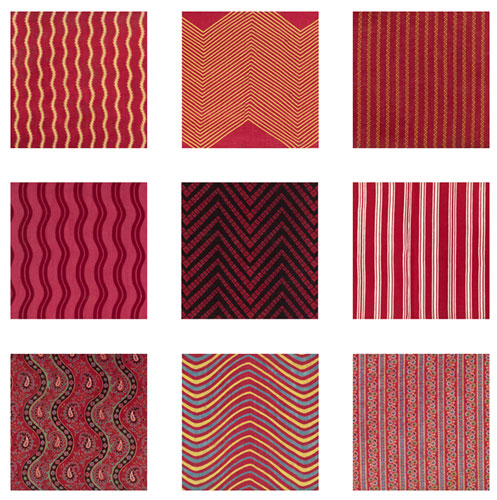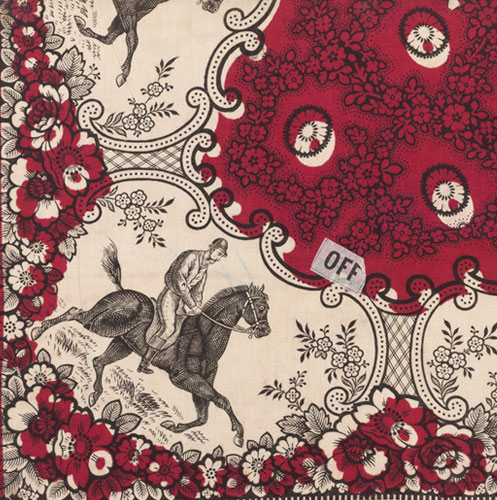Working with Dr Sally Tuckett from Edinburgh University I was given the task of photographing examples of Turkey red for an online exhibition hosted by National Museums Scotland. Due to the specific nature of the samples colour accuracy and continuity were of paramount importance to the cataloguing of this collection.

The production of Turkey red dyed and printed cottons was a major industry in the west of Scotland, particularly in the mid to late nineteenth century. Although the extensive works were pulled down in the second half of the twentieth century, our knowledge of this industry is significantly aided by the survival of approximately 200 pattern books, now housed in the National Museums Scotland textiles collection.

These pattern books are the foundation for a new study into the wider Scottish decorative textile industry. The ongoing examination of these pattern books has shown the variety and longevity of Turkey red dyed and printed patterns, as well as providing insights into wider aspects of the textile industry, including issues of design, manufacture and trade.

The production of a colour-fast red dye that could withstand frequent washing and sunlight was a long-standing ambition of dyers in eighteenth-century Britain. Called ‘Turkey red’ because it originated from the Levant region, the original process, which was time-consuming and expensive, was based on the extraction of alizarin from the madder root, which was then fixed to the fibre using oil and alum, as well as a host of unsavoury ingredients such as sheep’s dung, bullock’s blood and urine.

Manufactured in millions of yards and in a huge variety of designs, few of these colourful textiles survive today, other than in the form of samples and designs in pattern books. Historians of textiles and dress have long recognized the importance of pattern books as sources.

Pattern books were kept by manufacturers as records of their designs, manufacturing processes or orders. The National Museums Scotland Turkey Red Collection consists of 200 bound and unbound pattern books.

In all there are approximately 40,000 items in the collection, consisting of Turkey red dyed and printed cotton samples. The condition of the pattern books and the individual samples vary considerably.

These were accessioned to the National Museums Scotland collections in the 1960s on the demise of the United Turkey Red Company in Scotland, and have been largely untouched ever since.

Turkey red printed fabrics were rarely encountered in everyday life in Britain other than by the industry’s workers, as the large proportion of goods were for such markets as Australia, New Zealand, Brazil, West Coast of Africa, East Asia and India. Many of the animals present in the designs represent the wildlife native to these export markets.

The Turkey red dyeing and printing industry in Scotland was concentrated in the Vale of Leven, Dunbartonshire. William Stirling and Sons established themselves as Turkey red printers in the early nineteenth century. Their main rivals in the Vale were two firms run by brothers, John Orr Ewing and Co. and Archibald Orr Ewing and Co.

Competition between the Vale of Leven firms was brutal, with much copying and theft of designs among the rivals. Knowing that such design espionage existed makes it harder to definitively say if a pattern book belonged to one or another firm. On present research, just 41 per cent of the National Museums Scotland volumes can be securely connected with a specific Turkey red manufacturer.

In 1898 William Stirling and Sons, John Orr Ewing and Co. and Archibald Orr Ewing and Co., along with Alexander Reid and Sons of Milngavie, amalgamated to form the United Turkey Red Co. Ltd. (UTR).

Having set up a temporary studio in building 15 at the National Museums Collection Centre, great care was taken with lighting and exposure to ensure consistent and accurate results whilst photographing a collection of samples that varied greatly in size, condition and colour.
Each sample was photographed with a colour chart, and a strict colour management work flow was set up to insure the digital processing of the images would maintain the colour integrity of the original sample.

The large files that we can produce show a level of detail within the design that is not always apparent to the naked eye.

Using extension rings on the lenses allowed us to produce extreme detail within the images, to the point where you can almost count the individual threads of the fabric.

The National Museums Scotland patterns books, particularly when the details they contain can be linked to other sources, are yielding a more subtle understanding of the Turkey red textile industry in Scotland than was formerly possible, showing us the rich and diverse character of this little understood industry. This joint project between National Museums Scotland and the University of Edinburgh is intended to bring a wider understanding of an aspect of the Scottish textile industry which had a global impact.
For further information about the project please visit www.colouringthenation.wordpress.com. Keep an eye on the National Museums Scotland website for more information on the online exhibition, due in 2013.
Additional text by Sally Tuckett and Stana Nenadic from “Colouring the nation”, a new in-depth study of the Turkey red pattern books in the National Museums of Scotland. Textile History.
